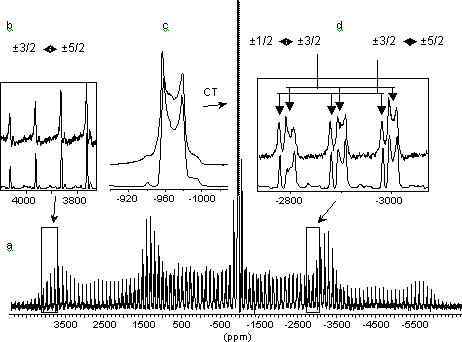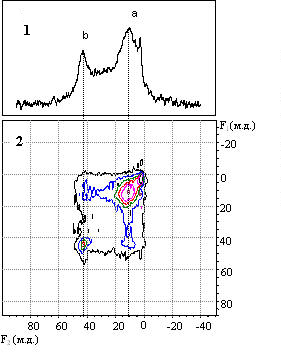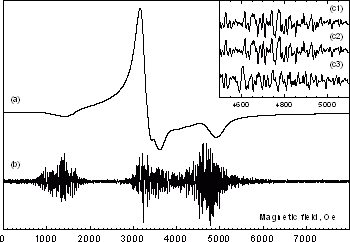Nuclear Magnetic Resonance (NMR)
Objects of study
Homogeneous and heterogeneous catalysts, reactions with their participation.
Applications
- In the homogeneous catalysis: study of the catalysts and substrates, as such (structure, local surroundings, properties) and in situ, without separation and isolation of reaction products, study of the catalytic reaction intermediates.
- In the heterogeneous catalysis: structure of solid catalysts (bulk and supported), study of the active surface sites, adsorption complexes and reactions on the catalyst surface.
Instrument facilities
Bruker AVANCE-400 (magnetic field 9.4 T) and Bruker AVANCE-400/microtomograph (magnetic field 9.4 T) NMR spectrometers for liquid-state and solid-state spectroscopy with a representative set of probeheads for any applications:
- high-resolution probeheads for liquids for all range of frequencies;
- broadband high-power probeheads for all range of frequencies and temperatures from +100 to –150°C;
- multinuclear X/1H dual-channel probeheads for the experiments with sample magic angle spinning with various rotation frequency (up to 35 kHz) and possibility to experiments with cross-polarization;
- MICRO2.5 probehead for microtomography with gradient for broadband system.
Additional possibilities
1. Home-built high-temperature (up to 600°C) probeheads for studies of molten state.
2. High-speed probeheads MAS: 7 mm - for rotation frequency up to 7 kHz; 4 and 5 - for rotation frequency up to 15 kHz; 2.5 mm - for rotation frequency up to 35 kHz.
3. MAS experiments under controlled atmosphere conditions in sealed ampoules.
4. Solid – state NMR technique for quadrupolar nuclei with a half-integral spin:
- SATRAS - SAtellite TRAnsition Spectroscopy
- MQMAS - Multiple-Quantum MAS NMR
- MASSA - Magic angle spinning And Static Spectra Analysis
- Spinning sideband analysis of the selected transitions
Samples requirements
Sample volume – from 0.1 to 5 cm3 depending on nucleus type.

Fig. 1. a – experimental 93Nb MAS NMR spectrum of Li3NbO4, obtained in the field of 9.4 T in 4 mm probehead with rotation frequency νr = 10 kHz; b – satellite transitions ±3/2 ‹-›±5/2; c – central transition ±1/2 ‹-›±1/2; d – satellite transitions ±3/2 ‹-›±1/2 and ±3/2 ‹-›±5/2 (buttom spectrums corresponds to the theoretical spectrums at the following parameters:
CQ = 11.5 MHz, ηQ = 0.1, δiso = -950 ppm, γr = 10 kHz)

Fig.2. 1 – Spectrum 129Xe NMR for xenon adsorbed on carbon nonotubes.
2 – Two-dimensional spectrum EXSY 129Xe NMR for xenon adsorbed on carbon nonotubes;
blending time is 10 ms, the equilibrium pressure of xenon is 100 kPa.
Leading scientists and their research interests
Prof. E.P. Talsi. In situ NMR and EPR study of the structure and reactivity of the active intermediates in homogenous catalytic oxidation of alkanes and alkylbenzenes, olefines epoxidation and polimerization reactions.

Prof. M.A. Fedotov. NMR study of the coordinate compounds structure for molybdenum, tungsten and metals of platinum group in the solutions and their catalytic properties. The author of the monographs “Nuclear magnetic resonance in solutions of inorganic compounds” and “Nuclear magnetic resonance in inorganic chemistry”.
Prof. O.B. Lapina. Solid-state and high-temperature NMR studies of the structure and mechanism of formation of the active sites of heterogeneous catalysts.
Prof. A.G. Stepanov. Study of hydrocarbon conversion on solid catalysts, reactions mechanism and products analysis including in situ.
Dr. R.I. Maximovskaya. Structure and conversions of polyoxometallates in solutions according to the data of polynuclear NMR spectroscopy.
Dr. K.P. Bryliakov. Study of structure of intermediates in reactions of asymmetric oxidation.
Dr. D.A. Babushkin. NMR spectroscopy researches of intermediates in homogeneous catalytic reactions of oxidation and polymerization, determination of structure for organic, metalorganic and complex compounds, the analysis of functionalized polymers.
Electron Paramagnetic Resonance (EPR)
Objects of study
- Liquids and solids: homogeneous and heterogeneous catalysts, supports.
- Catalytic reactions.
Applications
- Determination of the structural and electron characteristics (oxidation state, coordination sphere, symmetry) of paramagnetic ions - active sites of heterogeneous and homogeneous catalysts.
- Study of paramagnetic centers on the surface (free radicals, metal complexes, adsorption complexes) and of the reactions which they are involved in.
- Precise measurements of the magnetic resonance parameters and paramagnetic centers concentration within the wide temperature range (from -196 to +600°C).
Instrument facilities
- Bruker ER 200D EPR spectrometer allows to record X-band EPR spectra ( λ=3 cm–1 ) in the temperature range from -196 to +300°C. High-frequency magnetic field modulation can take two fixed values: 100 and 12.5 kHz. Spectrometer records the first and second derivatives of the absorption line. Scans accumulation and mathematical simulations of the spectra are available. Maximum sensitivity is 5·1010/Gauss per 0.1 cm3 sample.
- Experimental setup for in situ EPR study of radical and ion-radical intermediates of the catalytic reactions that take place on oxide catalysts surface.
Additional possibilities
Original technique for estimation of the properties and the active sites concentration on different oxide catalysts surface using non-traditional spin probes.
Samples requirements
Volume of the liquid or solid sample over 1 cm3.
Leading scientists and their research interests
Prof. E.P. Talsi. In situ NMR and EPR study of the structure and reactivity of the active intermediates in homogenous catalytic oxidation of alkanes and alkylbenzenes, olefines epoxidation and polimerization reactions.
Prof. A.M. Volodin. EPR study of radical and ion-radical reactions on oxide catalysts surface (dispersed oxides); development of spin-probes application techniques for heterogeneous catalysts active sites investigations.
Dr. K.P. Bryliakov. EPR studies of kinetics and mechanism of the reactions catalyzed by transition metal complexes. EPR of transition ions with S > 1/2.
Electron Ferromagnetic Resonance Spectroscopy
Objects of analysis
Dispersed ferro- and ferrimagnetics, magnetic layers, any solid and liquid samples, containing magnetic particles.
Applications
- Determination of geometric and magnetic characteristics for dispersed magnetics and layers.
- Investigation of interparticle magnetic interaction in dispersed magnetics.
- Investigation of magnetization process in magnetic nanoparticles.
- In-situ investigation of magnetic phase in various catalytic systems including the stage of its formation.
- Study of physicochemical processes with magnetic surface participation.
Instrument facilities
ESR spectrometer Bruker-200, ESR spectrometer Bruker-EMX (from the EPR Center of Collective Use in Siberian Brunch) allow to study in-situ at temperatures from 77 K to 500 K.
- The new type of FMR spectra of dispersed magnetics (Fine Structure of Ferromagnetic Resonance) revealed in BIC essentially extends possibilities of FMR method owing to considerable increasing of resolution and sensitivity (up to 2 orders of magnitude). Sensitivity of the FMR method for ferromagnetic phase is ≤ 10–6 g.

The FMR spectrum of Ln0.7Pb0.3MnO3 single crystal:
(a) – general view, (b) – the FMR fine structure obtained after the subtraction of the smooth background component.
In the insert (c1), (c2) – a sequence of FMR FS spectra obtained in independent registration series at unchangeable specimen position in the spectrometer cavity, (c3) the specimen is turned by 5°, Treg=296 K.
Samples requirements
Maximal size of solid sample is 8 mm.
Leading scientists and their research interests
Prof. V.F. Yudanov and Dr. O.N. Martyanov. Dispersed magnetics, magnetic layers.
Ultraviolet-Visual (UV-VIS) Adsorption Spectroscopy, Near Infrared (NIR) Spectroscopy
Objects of study
Solutions and solids, inorganic and organic substances.
Applications
- The determination of oxide defects and defect types.
- The determination of forms for the transition metal ion stabilization on the supports (valent state and coordination number).
Instrument facilities
Carl Zeiss Jena UV-VIS Specord M40 Spectrophotometer with a diffusion reflection accessory allows to record ultra-violet and visible (UV-VIS) spectra of solid samples in the range 45000 – 11000 cm–1.
Shimadzu UV-VIS 2501 PC Spectrophotometer with a diffusion reflection accessory, operation range – 53000 – 11000 cm–1.
Spectrolab Interspec 2010 NIR Fourier spectrometer with a diffusion reflection accessory allows to record the solid sample spectra in the near infrared region (NIR) 10000 - 3500 cm–1.
Samples requirements
For UV-VIS: powder – not less than 1 cm3; non-transparent film – 2x2 cm2.
For near IRS: powder – not less than 0.5 cm3; film – 1x1 cm2.
For UV-VIS, NIR: solution – about 1 cm3, concentration of the substance to be defined in the solution – 10–5 mol/l and higher.
Leading scientists and their research interests
Prof. E.A. Paukshtis and T V. Larina. Electron and coordination state of the cations and nature of its bonding with ligands in oxide heterogeneous catalysts and solutions.
Dr. G.V. Odegova. Stabilization of the surface complexes of transition metals.
Infra-Red Spectroscopy (IRS)
1. Bruker IFS-113V, Shimadzu 8300 Infrared Fourier-spectrometers
Applications
- Study of the solid surface: surface functional groups, surface acid-base properties, adsorbate functional groups.
- Quantitative characterization of the surface acid properties.
- Quantitative analysis of the gases containing aggressive compounds: NO2, SO2, SO3, HCl.
Instrument facilities
Varian FTIR-800 and Bruker Vector-22 IR Fourier-spectrometer are adapted for the study of solid surface. The operating range is 400–7800 cm–1, resolution – up to 1 cm–1, time of 1 spectrum recording is 1 second.
Shimadzu 8300 IR Fourier spectrometer is used for these purposes as well. The operating range is 300–6000 cm–1. Resolution – 1 cm–1, signal/noise ratio is higher than 2000. Time of 1 spectrum recording is 3 seconds. The surface is studied by the methods of in situ transmission (in the temperature range from –196 to +700 oC) and diffusion reflection (from –60 to +200 oC) in the controlled gas mixtures or vacuum.
The determination of gas molecule concentration to 1 ppm in a small pan (lower 50 cm3) is possible.
Additional possibilities
Original methods have been developed for the quantitative measurement of surface acid properties by low-temperature CO adsorption. (E.A.Paukshtis “Infrared spectroscopy in the heterogeneous acid-base catalysis”, Novosibirsk: Nauka, 1992)

An example of IR spectra observed in the course of CO adsorption over H-ZSM-5 zeolite.
IR spectra of the initial OH groups are shown by the dotted line.
The solid line corresponds to the spectra of OH groups in H-complexes with CO.
From the spectra it is evident that the zeolite is characterised by two types of Lewis acid centers (bands 2217 and 2227 cm–1) and two types of Brönsted acid centers (OH group bands 3294 and 3400 cm–1). Such a subtle difference between acid centers is impossible to register by other methods.
Samples requirements
Weight of the solid sample – 500 mg, for gases – 100 cm3.
2. Bomem M-102 Infrared Fourier-Spectrometer
Applications
- In solutions: definition of stoichiometric composition and complex compound structure in organic solutions, study of their solvation and hydration, study of the composition and construction of molecular associates (molecular groups, micelles).
- In solid sample: definition of the phase composition including amorphous phases (coordination metal surroundings, type of the multi-atom ligand and others)
- On the surface of gas-solid interface: study of the interaction of adsorbed organic molecules with surface; study of the surface intermediates during catalytic reactions, kinetics study (in situ studies).
- Definition of the defective oxide structure.
- Estimation of the organic substances concentration in the organic solutions and gas phase. The concentration of non-equivalent (having different surroundings) organic molecules is defined in the complex multi-component solutions.
Instrument facilities
The spectra of gaseous, liquid and solid samples in the frequency range 230 – 4000 cm–1 are acquired by Bomem IR Fourier-spectrometer. The program for spectra analysis allows to acquire high quality spectra for very dilute organic solutions. With CCl4 as a solvent it is possible to study the solutions with the concentration up to 0.5 × 10–3 mol/l.
Additional possibilities
- Photo-acoustic accessory allowing to record vibration spectra of the surface layer of solids is available .
- Methods for the study of composition and structure of the individual compounds forming in complex multi-component systems are developed.
- Development of the methods for estimation of small quantities of organic compounds (petroleum products, phenols and others) in the industrial water exhausts, in sewage and others.
Samples requirements
Weight of solid sample (without considering inert support) – not less than 3 mg.
Volume of solution – not less than 2 ml and solvent used – not less than 2 ml.
For photoacoustic IR spectra acquisition the volume of powdery sample is 1 cm 3.

Leading scientists and their research interests
Prof. E.A. Paukshtis. Quantitative basis of the definition of surface acid-base properties, all fields of IR spectroscopy of adsorbed molecules. The author of monograph “Infrared spectroscopy in heterogeneous acid-base catalysis” (in Russian).
Prof. E.S. Stoyanov. Composition and structure of molecular associates and complexes in water and organic solutions, and on the interface of solid-gas, solid-liquid and liquid-liquid.
Dr. E.B. Burgina. Theoretical analysis of experimental vibrational spectra, experimental IR (including NIR) and Raman spectral investigations.
Dr. G.N. Kustova. Analysis of defective oxides structure with IR spectroscopy.
Dr. D.V. Kozlov. Study of the chemical processes on oxides surface (TiO2).
Fluorescent Analysis
Objects of study
- Liquids and solids, organic and inorganic substances.
- Reactions.
Application
- Substance determination: high technique sensitivity allows to determine the small substance concentrations and estimate the degree of substance purity.
- Study of the rapid reactions of excited molecules, acid-alkaline reactions of the excited molecules and excited electron state complexing. Due to a high sensitivity the method permits to determine a low degree of conversion and elucidate the mechanism of chemical reaction by the intermediates.
- In biology – study of the protein structure by the method of fluorescent probes and tags.
Instrument facilities
RF-5000 Spectrofluoremeter (Shimadzu, Japan). The wavelength range of the excitation monochromator is 200–700 nm. The wavelength range of fluorescence monochromator is 200-700 nm. The xenon lamp with a capacity of 150 wt serves as an emitter. Recording of the spectra of emission, excitation, synchronous spectra is accomplished.
Leading scientists
Prof. D.I. Kochubey.
Dr. G.V. Odegova.


